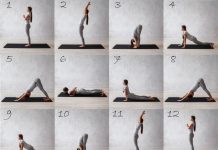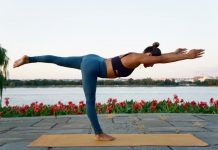Yoga is made up of many various elements that create a full body and mind experience that helps create a sense of wellness, serenity, and mindfulness. One of the most notable elements of yoga is sun salutations.
The sun salutation is a series of movements performed with fluidity throughout the practice to create seamlessly flowing movements. For every pose undertaken, breathing is aligned so that when you inhale you extend, and exhale when you bend. Sun salutations are normally used as a warm up prior to a full yoga session, they are used to build heat within the body and help to relax and loosen up the muscles before performing more complex movements and routines.
As with any type of exercise and activity, it is important to warm up the body beforehand to avoid injury or strain to the muscles, be it running, swimming or aerobics. Yoga is no different and it is best to be relaxed and stretched out before commencing a session. So what are the common sun salutations? And how do you perform them? Carry on reading below to find out the basics.
The Standing Mountain Pose
The standing mountain pose improves posture and will help relax and loosen up every major muscle in the body. There is also evidence that it can help reduce back pain over time and helps strengthen the glutes (buttocks), stomach muscles, thighs, knees, and ankles.
To perform the standing mountain pose, begin with placing your feet together and your arms at your side. Spread your weight evenly across the heels and arches of your feet.
Then move your feet to be hip-width apart and place your hands in the prayer position directly in front of your chest area. Hold this pose and take several deep breaths, being conscious of sucking in your stomach, buttocks and tightening your calf muscles on every inhale and loosening them on every exhale.
When performing this pose, make sure to stand as tall and straight as possible, extending every muscle in your body upwards until you can no longer extend any further.
The Standing Forward Fold
The standing forward fold pose improves helps improve serenity, calmness and relieves stress by placing the head lower than the heart level. It also helps give the hamstrings and calves a deep conditioning and relieves tension and stress from the neck, shoulder and facial muscles.
To perform the standing forward fold pose, begin with the standing mountain pose placing your feet together and your hands on your hips. Spread your weight evenly across the heels and arches of your feet.
Then move your feet to be hip-width apart and bend at the hip area, extending your body forwards and down towards your legs. Hold this pose and take several deep breaths, being conscious of sucking your belly button up towards your spine. Reach your arms down towards your ankles and then wrap your hands around them, hold the pose for up to one minute before slowly returning to the standing mountain pose.
When performing this pose, make sure to keep your legs straight, do not bend at the knees. If you can not reach your ankles, place an steady object such as a chair in front of you and hold on to that instead.
The Upward Salute
The upward salute pose is seen by many as a way to extend and stretch out the whole body with ease and is suitable for every level of yoga, from beginners to gurus. It is similar to the way that people stretch their bodies after getting out of bed or being sat down for a long period of time and activates every body part from the toes to the tips of the fingers. It also helps alleviate tension, fatigue, and anxiety and creates a feeling of renewed energy.
To perform the upward salute pose, begin with placing your feet together and your arms at your side. Spread your weight evenly across the heels and arches of your feet, if this is hard for you to do, place your feet around 6-8 inches apart.
Next, start to stretch out your body, starting at the ankles, then the knees and hips, extending them in a full stretch. Inhale deeply and sweep your arms outwards to the side and stretch them out above your head before placing the hands together in a prayer style position. Arch your back gently and lift your face towards the sky, stretch the entire body fully and then exhale and reverse the motions.
When performing this pose, make sure to extend your limbs fully. You should experience a pleasant sensation the same as when you stretch after waking up.
The Upward Facing Dog
The upward facing dog pose helps stretch out and relax the chest and spine while helping build strength in the wrists, elbows, and shoulders. The upward dog also helps create a supple spine, reducing back pain, and helps firm and tighten the abdomen, buttocks, and thighs.
To perform the upward facing dog pose, begin laying on the floor, stomach side down. Your legs should be extended and be a few inches apart. Point your toes away from your head in a horizontal line.
Then place your hands on the floor level with your lower ribs, and gently push upwards, lifting your upper body and hips off of the floor. Lightly bend you back and lift your face to the sky and push the tops of your feet firmly into the ground, inhale deeply and extend through your arms. Hold the pose for 20 seconds and then reverse the motion back to a laying position.
When performing this pose, it is recommended to repeat 4-5 times for maximum benefit. When you return to the starting position, allow your arms to relax by your sides and place you cheek on alternating sides for each turn.
The Downward Dog Pose
The downward facing dog pose is one of the best-known yoga poses throughout the western world and helps strengthen the glutes (buttocks), stomach muscles, thighs, knees, and ankles. It also helps build up strength and agility in the upper body, shoulders, elbows and wrists.
To perform the standing mountain pose, begin with placing your hands and knees on the floor. Place your hands directly under your shoulder location and your knees beneath your hip area. Point and extend your middle fingers out in front of you.
Then gently suck your belly button towards your spine and start to lift your buttocks into the air, straight up. Keep your arms and legs straight, do not bend at the knees or elbows. The body should now resemble an upside down V with your buttocks being the highest point. Breath in deeply and hold the pose for up to 30 seconds before reversing the position back to the starting pose.
When performing this pose, make sure to breathe throughout, taking deep yet gentle breaths in a natural rhythm.
Conclusion Of Sun Salutations
Now you know the basics of sun salutations and how to perform the basic movements associated with them, why not give them a try. They help create an all round feeling of wellness and good health while promoting a better state of mind and a plethora of added health benefits. Sun salutations should form the building blocks of every yoga session to ensure the risk of injury is minimized and the feeling of wellbeing is maximized.
47 Most Famous Motivational Quotes of All-Time
49 Greatest Love Quotes
37 Inspirational Quotes that Will Change Your Life






























